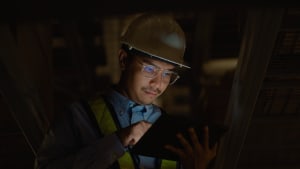How to get power grids ready for prime time
Solar and wind power are forecasted to supply more than a third of all electricity by 2030. To reach this ambitious target, we'll need a tremendous investment in global grid infrastructure.
We’re at a historic tipping point. Renewable energy sources grew at record rates in 2022, but even so they only covered 80 percent of the growth in electricity demand. Electricity emissions still went up.
This year, in 2023, it is likely that the world will add enough solar and wind generation to cover more than the additional electricity demand. From here on, electricity will only get cleaner. It’s expected that in 2040 the electricity sector will become one of the first to officially reach net zero.
To achieve current national energy and climate goals, the world’s electricity use needs to grow 20 percent faster in the next decade than it did in the last. Enormous investment is already planned with solar and wind forecast to supply more than one-third of all electricity by 2030, compared to just 12 percent today.
Reaching these goals and adapting to the exponential growth of renewables will require massive infrastructure investment. We will need to add or refurbish more than 50 million miles (80 million kilometers) of power grid infrastructure by 2040. This is equivalent to the entire existing global grid.
Current power grids are not future-ready
Upgrading and expanding grid infrastructure is a notoriously slow and complicated process. It involves many regulations, public consultations, skilled labor, community support, and procurement of required materials and equipment. All of this and many other challenges can slow down the transition.
In the United Kingdom (U.K.) clean energy projects can face up to a 15-year wait to connect to the grid. There are complex issues at play and a major overhaul of the grid is planned, but many countries are confronted with similar challenges.
We surveyed nearly 850 senior executives from nine industries and 22 countries, including their views on which energy transition barriers (out of 15) would increase or decrease in difficulty over the next five years. Electric power grid limitations was the barrier most expected to increase for respondents from North America. It was also the fourth highest globally after ‘front of mind’ issues such as higher costs of equipment and technology, higher energy costs and interest rates.
Coping with an exponential increase in renewable energy generation
Those that are concerned about power grids have likely taken note of just how much new renewables generation is already being planned.
The United States (U.S.) Government aims to deploy 30 gigawatts of offshore wind by 2030 and establish a pathway to deploy 110 gigawatts or more by 2050. The U.K. government has set a target to deploy 50 gigawatts of offshore wind by 2030 — over three and a half times the 13.7 gigawatts currently produced. Globally, offshore wind is expected to grow by more than 380 gigawatts over the next ten years, with installations planned for every continent except Antarctica.
This will include floating wind farms, taller wind turbines and new interconnectors that bring electricity onshore where it needs to be connected to the grid. Adapting to this and all the other new sources of renewable energy requires nothing short of a transformational shift in the way our power systems operate.
Already today, in Australia, the U.K., Chile and many other countries, renewable energy generators are switched off because grid infrastructure and/or storage capacity simply cannot cope.
In some markets, energy industry organizations are building battery storage, pumped-hydro facilities or hydrogen electrolyzers close to sources of renewable energy. This makes use of surplus energy that cannot be distributed by existing grid infrastructure. Indeed, the majority (57 percent) of senior executives we spoke to say that hydrogen is a major part of their energy transition strategy.
We need a resilient power grid that can efficiently transmit and distribute energy from new, widely distributed sources. We also need systems and infrastructure to store or use excess renewable energy.
So how do we get there?
Three fundamentals to ensure our power grids are ready for prime time
Strategic planning
Planning for the next generation of power grids is essential. This includes forecasting demand, adapting to new sources of supply and storage assets, digitalization and improved resilience.
The State of California in the U.S. has developed a strategic plan for modernizing its power grid. This plan is notable for its broad focus, including identification of the mix of resources needed to meet demand. It includes proposals to maximize demand flexibility, which will help citizens voluntarily manage their electricity consumption. Further, the plan addresses grid upgrades, expansion and modernization, permit streamlining, reliability, resilience, regional grid cooperation, affordability and more.
Smart grid technologies
Equipped with advanced sensors and real-time data analytics, smart grids enable the efficient management of energy flows, demand response and the integration of diverse energy sources.
Smart grid technologies are essential for grid modernization because they match the supply and demand of electricity, helping grid stability and market efficiency. These technologies can detect power outages and channel electricity to areas of need, minimizing the effects on customers and the environment. They can also enable two-way communication between utilities and appliances, which allows power needs to be adapted to supply shortfalls.
“Technology is essential to improving the grid,” says Landon Derentz, Senior Director and Morningstar Chair at the Atlantic Council Global Energy Center in the U.S.. “We're going to rely on digital technologies to maximize the efficiencies in our grid and our energy systems. Today, we need to support innovation in this area to create a future clean energy system based on renewable energy, hydrogen and other clean energy infrastructure.”
Innovative regulatory frameworks
Regulations play a crucial role in incentivizing clean energy adoption, setting standards for grid modernization and ensuring that utilities prioritize environmental sustainability.
Innovative regulatory frameworks accelerate the time taken to deploy new technologies and associated infrastructure, such as electrical power grids. These frameworks should also incentivize investments, research and development. Taking a ‘whole system’ view — looking at the breadth of technology needed to support energy transition goals — will allow regulators to validate and create a framework for the wide range of technologies that support grid modernization.
Regulations are key in supporting specific models or technologies. Integrating heat and power systems, for instance, can be achieved with specific frameworks, rules and incentives. In Denmark this has helped the country become one of the most energy efficient in the world, with 64 percent of households connected to district heating. Denmark’s regulations give city councils, utilities and other stakeholders the job of 'heat planning' for each municipal area.
Adapting power grids to clean energy sources is an urgent necessity. The intermittent nature of renewables, along with their decentralized distribution, pose unique challenges for our existing grids. Effective planning, the implementation of smart grids and appropriate regulatory frameworks are all vital to get our grids ready to fully support the energy transition.
-
Article
![]()
Resilience in the next generation of power grids
Cybersecurity is top priority for electrical power grids during this era of transformation to a decarbonized electricity system.Resilience in the next generation of power gridsCybersecurity is top priority for electrical power grids during this era of transformation to a decarbonized electricity system. -
Article
![]()
What do you need to build the energy workforce of the future?
Organizations are facing a massive skills shortage. They have to retrain or hire people to operate a more digital, data-driven business that will help them make the transition to clean energy.What do you need to build the energy workforce of the future?Organizations are facing a massive skills shortage. They have to retrain or hire people to operate a more digital, data-driven business that will help them make the transition to clean energy.


